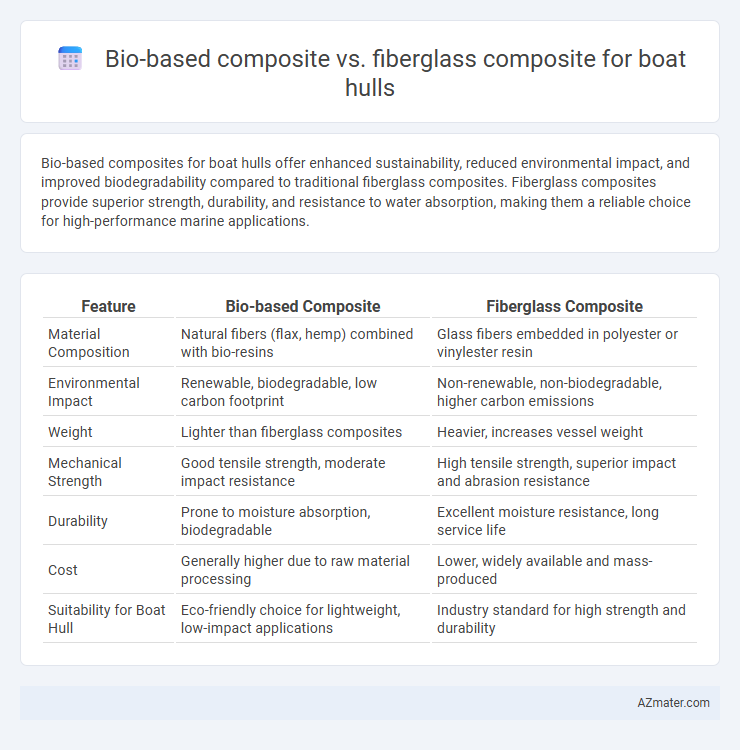Bio-based composites for boat hulls offer enhanced sustainability, reduced environmental impact, and improved biodegradability compared to traditional fiberglass composites. Fiberglass composites provide superior strength, durability, and resistance to water absorption, making them a reliable choice for high-performance marine applications.
Table of Comparison
| Feature | Bio-based Composite | Fiberglass Composite |
|---|---|---|
| Material Composition | Natural fibers (flax, hemp) combined with bio-resins | Glass fibers embedded in polyester or vinylester resin |
| Environmental Impact | Renewable, biodegradable, low carbon footprint | Non-renewable, non-biodegradable, higher carbon emissions |
| Weight | Lighter than fiberglass composites | Heavier, increases vessel weight |
| Mechanical Strength | Good tensile strength, moderate impact resistance | High tensile strength, superior impact and abrasion resistance |
| Durability | Prone to moisture absorption, biodegradable | Excellent moisture resistance, long service life |
| Cost | Generally higher due to raw material processing | Lower, widely available and mass-produced |
| Suitability for Boat Hull | Eco-friendly choice for lightweight, low-impact applications | Industry standard for high strength and durability |
Introduction to Composite Materials in Boat Hulls
Composite materials in boat hulls combine fibers and resin matrices to enhance strength, durability, and corrosion resistance. Bio-based composites utilize natural fibers like flax or hemp combined with bio-resins, offering eco-friendly alternatives with reduced carbon footprints. Fiberglass composites remain prevalent for their high strength-to-weight ratio, ease of fabrication, and superior mechanical properties critical for marine environments.
What Are Bio-based Composites?
Bio-based composites for boat hulls consist of natural fibers such as flax, hemp, or kenaf combined with bio-resins derived from renewable resources like soybean oil or corn starch, offering enhanced sustainability compared to traditional materials. Unlike fiberglass composites, which rely on synthetic glass fibers and petroleum-based resins, bio-based composites reduce environmental impact through biodegradability and lower carbon footprint during production. These materials provide competitive mechanical strength and durability, making them an eco-friendly alternative for lightweight and corrosion-resistant boat hull construction.
Understanding Fiberglass Composites
Fiberglass composites, consisting of glass fibers embedded in a resin matrix, are widely used for boat hulls due to their high strength-to-weight ratio and excellent durability in marine environments. These composites offer superior resistance to corrosion, impact, and fatigue compared to traditional materials, making them ideal for long-lasting watercraft performance. Fiberglass also allows for ease of molding complex shapes and provides a smooth finish critical for hydrodynamic efficiency.
Environmental Impact: Bio-based vs Fiberglass
Bio-based composites for boat hulls significantly reduce environmental impact by utilizing renewable materials like natural fibers and bio-resins, which lower carbon emissions and improve biodegradability. In contrast, fiberglass composites depend on petroleum-based resins and glass fibers, resulting in higher energy consumption, hazardous waste generation, and non-biodegradable marine debris. Lifecycle assessments demonstrate that bio-based composites offer a sustainable alternative with reduced ecological footprints and enhanced end-of-life recyclability compared to traditional fiberglass hulls.
Mechanical Properties Comparison
Bio-based composites for boat hulls exhibit enhanced environmental sustainability with competitive mechanical properties such as tensile strength and stiffness but generally have lower impact resistance and fatigue durability compared to fiberglass composites. Fiberglass composites demonstrate superior compressive strength, impact resistance, and long-term durability, making them a preferred choice for high-performance marine applications. Advanced bio-based composites using natural fibers combined with optimized resin matrices are closing the mechanical performance gap, offering a viable alternative for eco-friendly hull construction.
Weight and Performance Differences
Bio-based composites for boat hulls typically weigh less than fiberglass composites due to the natural fibers' lower density, enhancing fuel efficiency and maneuverability. Fiberglass composites offer higher tensile strength and durability, making them preferable for high-stress marine applications requiring robust impact resistance. The performance trade-off involves bio-based composites providing improved sustainability and weight reduction, while fiberglass ensures superior longevity and structural integrity.
Durability and Longevity Analysis
Bio-based composites for boat hulls offer enhanced environmental sustainability but often exhibit lower durability and shorter longevity compared to fiberglass composites, which are renowned for superior resistance to water absorption, impact, and UV degradation. Fiberglass composites typically maintain structural integrity and performance for 20-30 years under marine conditions, whereas bio-based composites may experience accelerated deterioration without advanced resin formulations and protective coatings. Selecting fiberglass composites ensures optimized hull lifespan and reduced maintenance costs, crucial for long-term marine vessel performance.
Cost Considerations for Boat Builders
Bio-based composites typically offer lower long-term costs due to sustainability incentives and reduced material disposal fees, making them attractive for eco-conscious boat builders. Fiberglass composites often have lower upfront costs and established supply chains, which can reduce initial material and labor expenses. Boat builders must weigh the bio-based composites' potential for higher durability and environmental compliance against fiberglass's cost efficiency and proven performance in marine environments.
Adoption and Market Trends
Bio-based composites for boat hulls are gaining traction due to increasing environmental regulations and consumer demand for sustainable materials, reflecting a significant shift in the marine industry towards eco-friendly alternatives. Market trends indicate a steady rise in the adoption of bio-based composites, driven by innovations in natural fiber reinforcements and bio-resin technologies that enhance durability and reduce carbon footprints. Despite fiberglass composites dominating the current market with established performance and cost advantages, the growing investment in green materials and government incentives is accelerating the bio-based composite market share in boat hull manufacturing.
Future Prospects in Marine Composites
Bio-based composites in boat hull construction offer promising sustainability benefits by reducing reliance on non-renewable resources and lowering carbon footprints compared to traditional fiberglass composites. Advances in natural fiber reinforcement and bio-resin technologies are improving mechanical strength and durability, making bio-based composites increasingly competitive for marine applications. Future prospects in marine composites emphasize enhanced environmental compliance and lifecycle performance, positioning bio-based composites as a key innovation for eco-friendly and high-performance boat hulls.

Infographic: Bio-based composite vs Fiberglass composite for Boat hull
 azmater.com
azmater.com